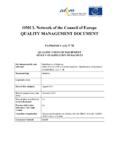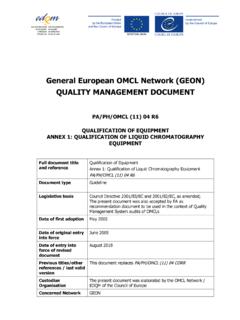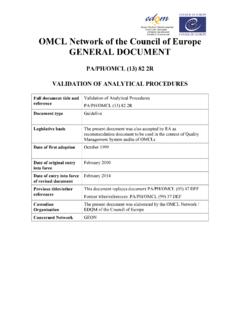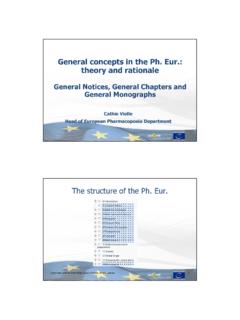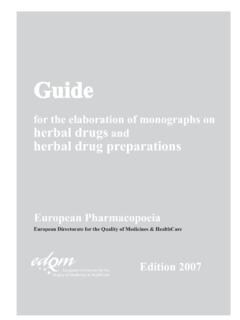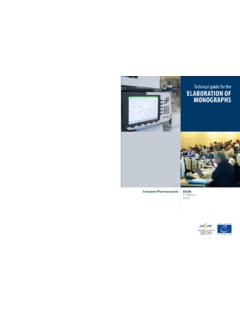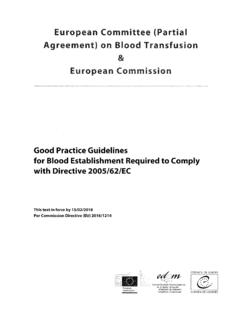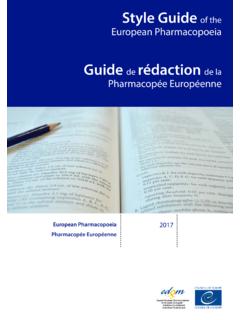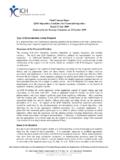Transcription of Implementation of ICH Q3D inthe Certification …
1 Certification of Substances DivisionAddress: 7 All e Kastner, CS 30026 F-67081 Strasbourg (France)Tel: +33 (0) 3 88 41 30 30 Fax: +33 (0) 3 88 41 27 71- e-mail: DOCUMENT((LLEEVVEELL11))PA/PH/CEP (16) 23 Strasbourg, August2016 Certification of suitability to the Monographs of the European PharmacopoeiaImplementation of ICH Q3D in the Certification ProcedureAddressesRoleDateTABFor adoptionJuly 2016 TABA dopted by correspondenceAugust 2016 EDQMPA/PH/CEP (16) 23 Certification of Substances DivisionPage 2 of 81. BackgroundThe ICH Q3D guideline on elemental impurities is effective in the European Union from June 2016 for new marketing authorisation applications and from December 2017 for authorised medicinal document is intended to serve as guidance on how to implement ICH Q3D in the procedure for Certification of Suitability to the monographs of the European Pharmacopoeia (CEP).
2 ICH Q3D covers 24 elements (classified under the followingclasses 1, 2A, 2B and 3) and gives permitted daily exposure (PDE) in drug products. ICH Q3D is not limited to reagents and catalysts in drug substance or excipients, but also considers all contributions from manufacture including manufacturing equipment,water and container-closure system. The ICH Q3D guideline emphasises developing a risk-based control strategy to limit elemental impurities which is summarised in an appropriate Risk Management Summary ScopeThis document describes the policy for elemental impurities in substances covered by a Certificate of Suitability to the monographs of the European Pharmacopoeia (CEP).
3 This documentcoverspharmaceutical substances introduced in medicinal productswithin the scope of ICH products outside the scope of Q3D, the applicant should control adequately the levels of elemental impurities in their reference documents taken into consideration when elaborating this policy are:- ICH guideline Q3D on elemental impurities (EMA/CHMP/ICH/353369/2013) and associated ICH training modules- elemental impurities in marketed products. Recommendations for Implementation (EMA/CHMP/ QWP/109127/2015)- Implementation strategy of ICH Q3D guideline Draft (EMA/404489/2016)This policy is applicable to new, renewedand revised CEPs granted from the 1stSeptember2016 (provided the applicant/holder has made reference to ICH Q3D principles in their application).
4 3. Implementation of the policyThe applicant is given 2 possible options in a CEP dossier: Provide a Risk Management Summary (RMS) for elemental impurities which may be present in the manufacturing process of the final substance. Do not provide a Risk Management Summary(RMS).The EDQM encourages applicants to provide a RMS. Submitting a RMS in a CEP application provides significant benefit as it will facilitate the risk assessment for the medicinal (16) 23 Certification of Substances DivisionPage 3 of Risk Management Summary Provided Applicants should clearly identify this option in their Risk Management Summary report should be provided in module 3 of the dossier, in the form of a Table, as described in Annex 1 of this document (preferably in CTD section impurities ).
5 This summary should detail the rationale used to conduct the study, and include ajustification of the control strategy implemented following the risk should be noted that where insufficient datais given for this option, the application will be considered as if no RMS is Requirementsfor CEP ApplicationsAs well as considering the principles outlined in ICH Q3D, the following points should also be taken into account when taking the RMS approach for a CEP application. How to build the RMS The RMS should consider all potential sources of contamination; including elemental impurities intentionally introduced into the process, contributions from raw materials (such as water), equipment, and intended route of administration / use of the substanceshould be indicated, which forms the basis of the risk management discussion.
6 Reference to unrealistic routes of administrationor usesnot pertaining to the known use of the substance will not be accepted. The RMS should consider all elemental impurities mentioned in ICH Q3D (as per the Elements to be considered in the Risk Assessment ). Meaning that:o Class 1 and 2A elements, as well as all elements intentionally added in the manufacture whatever their classification should be systematically If relevant, and depending of the use of the substance, Class 3 elements should be discussed. o Justification as to why specific elemental impurities were included in the scope of the RMS is considered useful information and should be to define the control strategy The control strategy should focus on the absence or presence of elemental impurities in the final substance.
7 Absenceof an elemental impurity can be concluded when it is shown with convincing evidence that it is purged to a level which is consistently below 30% of the calculated concentration limit based on the indicated route of administration and based on the option 1 daily intake (as per table of the ICH Q3D guideline), in a minimum of 3 commercial batches or a minimum of 6 pilot batches of the final substance. EDQMPA/PH/CEP (16) 23 Certification of Substances DivisionPage 4 of 8 When applicable, a justified specification for elemental impurities in the final substance should be introduced. For any elemental impurity intentionally introduced into the last synthetic step of the process, a specification in the final substance is expected(as this is associated with an elevated risk for impurities being carried forward),unless it is consistently and convincingly demonstrated that the process is capable to purge the impurity from the final substance to a level which is below 30% of the calculated concentration limit.
8 Screening results of several batches for elemental impurities alone cannot be considered as a risk management approach, but may support a RMS as described above. This might be done in a similar manner asis illustrated inappendix 4 of the guideline ICH Q3D. For the analytical methods used:o For screeningpurposes: The analytical methodology usedshould be mentioned along with minimum validation information such as indication of the specificity and sensitivity of the method (LOD/LOQ).o Control included in the specification of the final substance:A detailed description of the analytical method used should be provided which is suitable to be annexed to the CEP.
9 The analytical method should be validated in accordance with the requirements of ICH : Information reported on Certificates of SuitabilityWhen a RMS is provided, this will be mentioned on the CEP. A table summarising the conclusions of the RMS will be appended to the CEP as per the example given in Annex 1 of this table is intended to carry necessary information about the level of contamination of the substance source, in order to implement the ICH Q3D component approach in the finished medicinal relevant specification, as proposedby the applicant, will be mentioned on the CEP together with the corresponding analytical.
10 The EDQM assessors will not make a final conclusion on compliance with ICH Q3D, as this should be done within the context of the marketing authorisation applicationfor the medicinal product in which the substancecovered by the CEPis No Risk Management Summary Requirements for CEP ApplicationsIf no risk assessment has been performed, then the following points should be addressedin the CEP application: Any elemental impurities (whatever the Class) intentionally introduced in the manufacture of the final substance should be declared and data showing their level in the final substanceshould (16) 23 Certification of Substances DivisionPage 5 of 8 For any elemental impurity intentionally introduced into the last synthetic step of the process, a specification in the final substance is expected(as this is associated with an elevated risk for impurities being carried forward)

